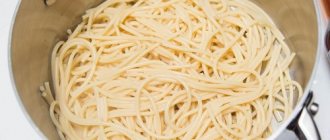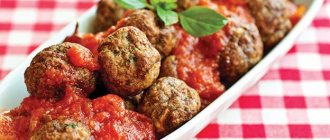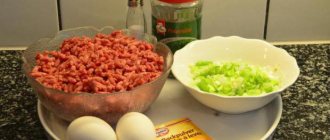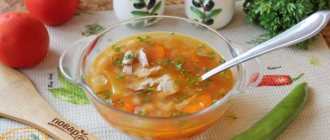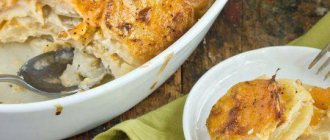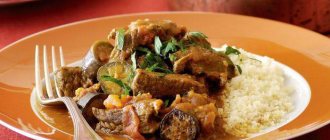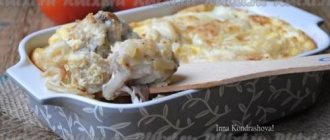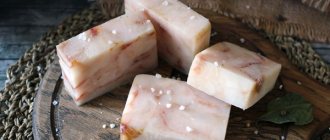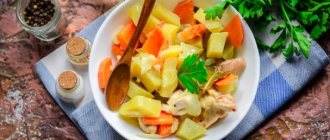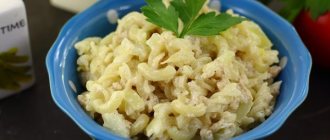There are many ways to prepare pollock. I suggest trying pollock in tomato-vegetable sauce in a slow cooker. Despite the rather simple cooking method, the fish turns out very tender and tasty! Boiled rice or mashed potatoes are ideal as a side dish. Moreover, pollock cooked in tomato sauce according to this recipe is tasty not only hot, but also cold. I first fry the fish on both sides in a frying pan; you can do this in advance in a slow cooker. In my opinion, the taste of the dish is brighter and more interesting, but if you wish, you can skip this step and stew the pollock without pre-frying. By the way, pollock in this recipe can be safely replaced with any fish with white meat, such as hake or blue whiting. Any white fish cooked in tomato sauce in a slow cooker will become a delicious second course, and cooking will not take you much time at all.
How to cook “Pollock in tomato sauce”
1. The recipe for cooking pollock in tomato sauce is quite simple. First you need to wash, dry and clean the fish. Cut it into portions.
2. Wash the carrots, peel and cut into thin slices. If desired, you can grate it, but the taste will be slightly different.
3. Peel the onions and cut into rings. Pour a little vegetable oil into the frying pan. Add carrots and onions and fry until the vegetables are soft.
4. Salt the washed and dried fish to taste. Then roll in flour and place in a separate frying pan with heated oil. Fry on both sides until golden brown.
5. When the fish is fried, it must be removed from the pan and placed on a paper napkin to remove excess fat.
6. Place half of the fried vegetables on the bottom of a high-sided frying pan. Place the fish and the other half of the vegetables on top.
7. Now you can prepare the tomato sauce. This option uses tomato juice, but you can also use pureed tomatoes and canned tomatoes in their own juice. Combine the juice, garlic, salt and spices squeezed out through a press in a separate bowl. Mix everything thoroughly.
8. Pour the resulting sauce over the fish and vegetables and send to the fire. Stewing pollock in tomato sauce at home will take about 35-40 minutes, and then the dish can be served immediately.
Pollock in tomato sauce - recipe
After all the ingredients have been prepared, you can start cooking pollock in tomato sauce. Cut off the fins of pollock carcasses with scissors or a knife. Rinse the inside of the fish carcass. As a rule, a pollock carcass is sold gutted, without entrails, but inside there is a black film on the walls of the abdomen. It is advisable to remove it.
Cut them into pieces approximately 3 cm wide.
Peel the bulbs. Cut them into half rings.
Wash, peel and grate the carrots on a coarse grater. If you want the tomato sauce to have a more uniform structure, then chop the vegetables more finely. The onion can be cut into small cubes, and the carrots can be grated on a fine grater.
Pour some vegetable oil into the frying pan. Add onions and carrots.
Simmer over low heat, stirring.
Add tomato paste to the stewed vegetables.
Place bay leaf. Add spices. Choose the quantity and type of spices according to your taste. If you want a more spicy fish stew with vegetables, add more spices, especially red pepper.
Add some salt.
Pour in water. It is not necessary to use boiled water. Stir all the ingredients of the tomato sauce in which the fish will be stewed.
Simmer it for about 5 more minutes. When the carrots become soft, add pollock pieces to the tomato sauce with onions and carrots. You can add a little more flour to thicken. A level tablespoon will be enough. Spoon the gravy over them with a tablespoon.
Simmer over low heat for about 5-7 minutes. Turn the pollock pieces over to the other side and simmer the fish in the sauce for another 5-7 minutes. Pollock is stewed very quickly and this time is quite enough for its preparation. If you simmer it longer, there is a chance that the pieces of fish will simply disintegrate into smaller ones.
Pollock in tomato sauce, just like herring, capelin or gobies in tomato, is delicious both hot and cold. This stewed fish can be served with buckwheat, pea porridge, pasta, rice, and mashed potatoes. Personally, I think that stewed pollock in tomato sauce goes best with mashed potatoes. You can also cook any other sea fish using this recipe.
Enjoy your meal. I will be glad if you liked this recipe for pollock in tomato sauce and find it useful. I highly recommend cooking fish and chips in the oven.
Recipe for pollock stewed in tomato sauce. Calorie, chemical composition and nutritional value.
Nutritional value and chemical composition of “pollock stewed in tomato sauce.”
The table shows the nutritional content (calories, proteins, fats, carbohydrates, vitamins and minerals) per 100 grams of edible portion.
| Nutrient | Quantity | Norm** | % of the norm in 100 g | % of the norm in 100 kcal | 100% normal |
| Calorie content | 99.3 kcal | 1684 kcal | 5.9% | 5.9% | 1696 g |
| Squirrels | 13.8 g | 76 g | 18.2% | 18.3% | 551 g |
| Fats | 4.1 g | 56 g | 7.3% | 7.4% | 1366 g |
| Carbohydrates | 1.7 g | 219 g | 0.8% | 0.8% | 12882 g |
| Organic acids | 0.1 g | ~ | |||
| Alimentary fiber | 0.6 g | 20 g | 3% | 3% | 3333 g |
| Water | 79.6 g | 2273 g | 3.5% | 3.5% | 2856 g |
| Ash | 1.086 g | ~ | |||
| Vitamins | |||||
| Vitamin A, RE | 161.9 mcg | 900 mcg | 18% | 18.1% | 556 g |
| Retinol | 0.007 mg | ~ | |||
| beta carotene | 0.913 mg | 5 mg | 18.3% | 18.4% | 548 g |
| Vitamin B1, thiamine | 0.087 mg | 1.5 mg | 5.8% | 5.8% | 1724 g |
| Vitamin B2, riboflavin | 0.087 mg | 1.8 mg | 4.8% | 4.8% | 2069 g |
| Vitamin B4, choline | 1.02 mg | 500 mg | 0.2% | 0.2% | 49020 g |
| Vitamin B5, pantothenic | 0.06 mg | 5 mg | 1.2% | 1.2% | 8333 g |
| Vitamin B6, pyridoxine | 0.151 mg | 2 mg | 7.6% | 7.7% | 1325 g |
| Vitamin B9, folates | 8.083 mcg | 400 mcg | 2% | 2% | 4949 g |
| Vitamin C, ascorbic acid | 5.2 mg | 90 mg | 5.8% | 5.8% | 1731 |
| Vitamin E, alpha tocopherol, TE | 1.886 mg | 15 mg | 12.6% | 12.7% | 795 g |
| Vitamin H, biotin | 0.254 mcg | 50 mcg | 0.5% | 0.5% | 19685 |
| Vitamin K, phylloquinone | 1.9 mcg | 120 mcg | 1.6% | 1.6% | 6316 g |
| Vitamin RR, NE | 4.7474 mg | 20 mg | 23.7% | 23.9% | 421 g |
| Niacin | 1.144 mg | ~ | |||
| Macronutrients | |||||
| Potassium, K | 314.66 mg | 2500 mg | 12.6% | 12.7% | 795 g |
| Calcium, Ca | 34.51 mg | 1000 mg | 3.5% | 3.5% | 2898 g |
| Magnesium, Mg | 41.33 mg | 400 mg | 10.3% | 10.4% | 968 g |
| Sodium, Na | 120.23 mg | 1300 mg | 9.2% | 9.3% | 1081 g |
| Sera, S | 172.5 mg | 1000 mg | 17.3% | 17.4% | 580 g |
| Phosphorus, P | 159.9 mg | 800 mg | 20% | 20.1% | 500 g |
| Chlorine, Cl | 326.99 mg | 2300 mg | 14.2% | 14.3% | 703 g |
| Microelements | |||||
| Aluminium, Al | 47.1 mcg | ~ | |||
| Bor, B | 28 mcg | ~ | |||
| Iron, Fe | 0.849 mg | 18 mg | 4.7% | 4.7% | 2120 g |
| Yod, I | 147.31 mcg | 150 mcg | 98.2% | 98.9% | 102 g |
| Cobalt, Co | 15.991 mcg | 10 mcg | 159.9% | 161% | 63 g |
| Lithium, Li | 0.391 mcg | ~ | |||
| Manganese, Mn | 0.1432 mg | 2 mg | 7.2% | 7.3% | 1397 g |
| Copper, Cu | 152.79 mcg | 1000 mcg | 15.3% | 15.4% | 654 g |
| Molybdenum, Mo | 5.111 mcg | 70 mcg | 7.3% | 7.4% | 1370 g |
| Nickel, Ni | 8.735 mcg | ~ | |||
| Rubidium, Rb | 51 mcg | ~ | |||
| Selenium, Se | 0.151 mcg | 55 mcg | 0.3% | 0.3% | 36424 g |
| Fluorine, F | 689.39 mcg | 4000 mcg | 17.2% | 17.3% | 580 g |
| Chromium, Cr | 54.8 mcg | 50 mcg | 109.6% | 110.4% | 91 g |
| Zinc, Zn | 1.2021 mg | 12 mg | 10% | 10.1% | 998 g |
| Digestible carbohydrates | |||||
| Starch and dextrins | 0.221 g | ~ | |||
| Mono- and disaccharides (sugars) | 1.6 g | max 100 g | |||
| Glucose (dextrose) | 0.5385 g | ~ | |||
| Sucrose | 0.7705 g | ~ | |||
| Fructose | 0.3937 g | ~ | |||
| Essential amino acids | 0.0763 g | ~ | |||
| Arginine* | 0.9948 g | ~ | |||
| Valin | 0.8895 g | ~ | |||
| Histidine* | 0.3956 g | ~ | |||
| Isoleucine | 1.0857 g | ~ | |||
| Leucine | 1.2841 g | ~ | |||
| Lysine | 1.7744 g | ~ | |||
| Methionine | 0.5892 g | ~ | |||
| Methionine + Cysteine | 0.7381 g | ~ | |||
| Threonine | 0.8903 g | ~ | |||
| Tryptophan | 0.1988 g | ~ | |||
| Phenylalanine | 0.6943 g | ~ | |||
| Phenylalanine+Tyrosine | 1.2887 g | ~ | |||
| Nonessential amino acids | 0.188 g | ~ | |||
| Alanin | 0.8905 g | ~ | |||
| Aspartic acid | 1.2048 g | ~ | |||
| Glycine | 0.7894 g | ~ | |||
| Glutamic acid | 1.3679 g | ~ | |||
| Proline | 0.5931 g | ~ | |||
| Serin | 0.6918 g | ~ | |||
| Tyrosine | 0.5943 g | ~ | |||
| Cysteine | 0.1493 g | ~ | |||
| Sterols (sterols) | |||||
| Cholesterol | 48.89 mg | max 300 mg | |||
| beta sitosterol | 6.5189 mg | ~ | |||
| Saturated fatty acids | |||||
| Saturated fatty acids | 0.6 g | max 18.7 g | |||
| 14:0 Miristinovaya | 0.0098 g | ~ | |||
| 16:0 Palmitinaya | 0.2999 g | ~ | |||
| 18:0 Stearic | 0.163 g | ~ | |||
| 20:0 Arakhinovaya | 0.0098 g | ~ | |||
| 22:0 Begenovaya | 0.0228 g | ~ | |||
| Monounsaturated fatty acids | 0.9322 g | min 16.8 g | 5.5% | 5.5% | |
| 16:1 Palmitoleic | 0.0391 g | ~ | |||
| 18:1 Oleic (omega-9) | 0.8507 g | ~ | |||
| Polyunsaturated fatty acids | 2.3501 g | from 11.2 to 20.6 g | 21% | 21.1% | |
| 18:2 Linolevaya | 1.9589 g | ~ | |||
| 18:3 Linolenic | 0.0098 g | ~ | |||
| 20:4 Arachidonic | 0.0293 g | ~ | |||
| Omega-3 fatty acids | 0.2 g | from 0.9 to 3.7 g | 22.2% | 22.4% | |
| 22:4 Docosatetraenoic acid, Omega-6 | 0.176 g | ~ | |||
| 22:6 Docosahexaenoic acid (DHA), Omega-3 | 0.1858 g | ~ |
The energy value of pollock stewed in tomato sauce is 99.3 kcal.
Primary Source: Created in the application by the user. Read more.
** This table shows the average levels of vitamins and minerals for an adult. If you want to know the norms taking into account your gender, age and other factors, then use the “My Healthy Diet” application.
Recipe: Pollock fillet in tomato sauce. Calorie, chemical composition and nutritional value.
Nutritional value and chemical composition of “Pollock fillet in tomato sauce.”
The table shows the nutritional content (calories, proteins, fats, carbohydrates, vitamins and minerals) per 100 grams of edible portion.
| Nutrient | Quantity | Norm** | % of the norm in 100 g | % of the norm in 100 kcal | 100% normal |
| Calorie content | 125.4 kcal | 1684 kcal | 7.4% | 5.9% | 1343 g |
| Squirrels | 6.5 g | 76 g | 8.6% | 6.9% | 1169 g |
| Fats | 7.8 g | 56 g | 13.9% | 11.1% | 718 g |
| Carbohydrates | 6.9 g | 219 g | 3.2% | 2.6% | 3174 g |
| Organic acids | 0.1 g | ~ | |||
| Alimentary fiber | 1.7 g | 20 g | 8.5% | 6.8% | 1176 g |
| Water | 74.3 g | 2273 g | 3.3% | 2.6% | 3059 g |
| Ash | 1.281 g | ~ | |||
| Vitamins | |||||
| Vitamin A, RE | 379.3 mcg | 900 mcg | 42.1% | 33.6% | 237 g |
| Retinol | 0.003 mg | ~ | |||
| beta carotene | 2.281 mg | 5 mg | 45.6% | 36.4% | 219 g |
| beta Cryptoxanthin | 0.552 mcg | ~ | |||
| Lycopene | 2554.579 mcg | ~ | |||
| Lutein + Zeaxanthin | 4.412 mcg | ~ | |||
| Vitamin B1, thiamine | 0.063 mg | 1.5 mg | 4.2% | 3.3% | 2381 g |
| Vitamin B2, riboflavin | 0.063 mg | 1.8 mg | 3.5% | 2.8% | 2857 g |
| Vitamin B4, choline | 27.75 mg | 500 mg | 5.6% | 4.5% | 1802 |
| Vitamin B5, pantothenic | 0.209 mg | 5 mg | 4.2% | 3.3% | 2392 g |
| Vitamin B6, pyridoxine | 0.103 mg | 2 mg | 5.2% | 4.1% | 1942 |
| Vitamin B9, folates | 5.777 mcg | 400 mcg | 1.4% | 1.1% | 6924 g |
| Vitamin B12, cobalamin | 0.541 mcg | 3 mcg | 18% | 14.4% | 555 g |
| Vitamin C, ascorbic acid | 3.16 mg | 90 mg | 3.5% | 2.8% | 2848 g |
| Vitamin D, calciferol | 0.064 mcg | 10 mcg | 0.6% | 0.5% | 15625 g |
| Vitamin E, alpha tocopherol, TE | 2.803 mg | 15 mg | 18.7% | 14.9% | 535 g |
| beta tocopherol | 0.004 mg | ~ | |||
| gamma tocopherol | 0.018 mg | ~ | |||
| Vitamin H, biotin | 0.426 mcg | 50 mcg | 0.9% | 0.7% | 11737 g |
| Vitamin K, phylloquinone | 3.2 mcg | 120 mcg | 2.7% | 2.2% | 3750 g |
| Vitamin RR, NE | 2.0086 mg | 20 mg | 10% | 8% | 996 g |
| Niacin | 0.657 mg | ~ | |||
| Betaine | 0.147 mg | ~ | |||
| Macronutrients | |||||
| Potassium, K | 280.91 mg | 2500 mg | 11.2% | 8.9% | 890 g |
| Calcium, Ca | 32.61 mg | 1000 mg | 3.3% | 2.6% | 3067 g |
| Silicon, Si | 6.245 mg | 30 mg | 20.8% | 16.6% | 480 g |
| Magnesium, Mg | 33.17 mg | 400 mg | 8.3% | 6.6% | 1206 g |
| Sodium, Na | 104.77 mg | 1300 mg | 8.1% | 6.5% | 1241 g |
| Sera, S | 80.33 mg | 1000 mg | 8% | 6.4% | 1245 g |
| Phosphorus, P | 119.2 mg | 800 mg | 14.9% | 11.9% | 671 g |
| Chlorine, Cl | 68.46 mg | 2300 mg | 3% | 2.4% | 3360 g |
| Microelements | |||||
| Aluminium, Al | 172.6 mcg | ~ | |||
| Bor, B | 92.9 mcg | ~ | |||
| Vanadium, V | 21.91 mcg | ~ | |||
| Iron, Fe | 0.845 mg | 18 mg | 4.7% | 3.7% | 2130 g |
| Yod, I | 25.2 mcg | 150 mcg | 16.8% | 13.4% | 595 g |
| Cobalt, Co | 6.802 mcg | 10 mcg | 68% | 54.2% | 147 g |
| Lithium, Li | 1.17 mcg | ~ | |||
| Manganese, Mn | 0.1837 mg | 2 mg | 9.2% | 7.3% | 1089 g |
| Copper, Cu | 109.52 mcg | 1000 mcg | 11% | 8.8% | 913 g |
| Molybdenum, Mo | 5.793 mcg | 70 mcg | 8.3% | 6.6% | 1208 g |
| Nickel, Ni | 4.483 mcg | ~ | |||
| Rubidium, Rb | 132 mcg | ~ | |||
| Selenium, Se | 4.64 mcg | 55 mcg | 8.4% | 6.7% | 1185 g |
| Strontium, Sr | 1.65 mcg | ~ | |||
| Fluorine, F | 264.37 mcg | 4000 mcg | 6.6% | 5.3% | 1513 g |
| Chromium, Cr | 19.64 mcg | 50 mcg | 39.3% | 31.3% | 255 g |
| Zinc, Zn | 0.7621 mg | 12 mg | 6.4% | 5.1% | 1575 g |
| Digestible carbohydrates | |||||
| Starch and dextrins | 2.66 g | ~ | |||
| Mono- and disaccharides (sugars) | 4.2 g | max 100 g | |||
| Glucose (dextrose) | 1.182 g | ~ | |||
| Maltose | 0.002 g | ~ | |||
| Sucrose | 2.489 g | ~ | |||
| Fructose | 0.833 g | ~ | |||
| Essential amino acids | 0.14 g | ~ | |||
| Arginine* | 0.432 g | ~ | |||
| Valin | 0.361 g | ~ | |||
| Histidine* | 0.162 g | ~ | |||
| Isoleucine | 0.435 g | ~ | |||
| Leucine | 0.526 g | ~ | |||
| Lysine | 0.69 g | ~ | |||
| Methionine | 0.228 g | ~ | |||
| Methionine + Cysteine | 0.292 g | ~ | |||
| Threonine | 0.36 g | ~ | |||
| Tryptophan | 0.085 g | ~ | |||
| Phenylalanine | 0.294 g | ~ | |||
| Phenylalanine+Tyrosine | 0.524 g | ~ | |||
| Nonessential amino acids | 0.299 g | ~ | |||
| Alanin | 0.369 g | ~ | |||
| Aspartic acid | 0.527 g | ~ | |||
| Glycine | 0.323 g | ~ | |||
| Glutamic acid | 0.8 g | ~ | |||
| Proline | 0.268 g | ~ | |||
| Serin | 0.291 g | ~ | |||
| Tyrosine | 0.241 g | ~ | |||
| Cysteine | 0.07 g | ~ | |||
| Sterols (sterols) | |||||
| Cholesterol | 16.06 mg | max 300 mg | |||
| beta sitosterol | 10.997 mg | ~ | |||
| Saturated fatty acids | |||||
| Saturated fatty acids | 0.7 g | max 18.7 g | |||
| 14:0 Miristinovaya | 0.004 g | ~ | |||
| 16:0 Palmitinaya | 0.366 g | ~ | |||
| 18:0 Stearic | 0.225 g | ~ | |||
| 20:0 Arakhinovaya | 0.015 g | ~ | |||
| 22:0 Begenovaya | 0.036 g | ~ | |||
| Monounsaturated fatty acids | 1.29 g | min 16.8 g | 7.7% | 6.1% | |
| 16:1 Palmitoleic | 0.015 g | ~ | |||
| 18:1 Oleic (omega-9) | 1.262 g | ~ | |||
| Polyunsaturated fatty acids | 3.522 g | from 11.2 to 20.6 g | 31.4% | 25% | |
| 18:2 Linolevaya | 3.124 g | ~ | |||
| 18:3 Linolenic | 0.006 g | ~ | |||
| 20:4 Arachidonic | 0.011 g | ~ | |||
| Omega-3 fatty acids | 0.1 g | from 0.9 to 3.7 g | 11.1% | 8.9% | |
| 22:4 Docosatetraenoic acid, Omega-6 | 0.065 g | ~ | |||
| 22:6 Docosahexaenoic acid (DHA), Omega-3 | 0.069 g | ~ | |||
| Omega-6 fatty acids | 3.2 g | from 4.7 to 16.8 g | 68.1% | 54.3% |
The energy value of pollock fillet in tomato sauce is 125.4 kcal.
Primary Source: Created in the application by the user. Read more.
** This table shows the average levels of vitamins and minerals for an adult. If you want to know the norms taking into account your gender, age and other factors, then use the “My Healthy Diet” application.

